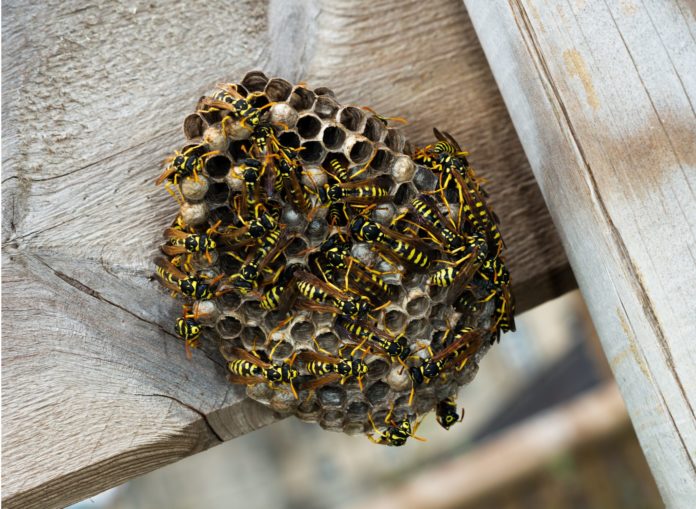AUBURN, Ala. – While helpful in controlling other insects, wasps are more known for their painful stings. The term wasp is somewhat generic. Hornets, mud daubers and yellow jackets are all wasps, with hornets and yellow jackets being the most common. With every occasional sting, a person’s chances of becoming sensitive to the venom increases. Knowing the basic information about these insects may reduce your chances of getting stung.
Yellow Jackets
Yellow jackets get their names from the yellow and black coloring on their bodies. They are commonly mistaken for bees, but they are actually highly aggressive wasps.
Xing Ping Hu, an Alabama Extension entomologist, said yellow jackets are responsible for almost all of the stinging deaths in the United States.
“Unlike other stinging insects, yellow jackets like to sting people,” Hu said. “Unlike honey bees, yellow jackets do not lose their stringer, so each insect can sting repeatedly and generally attack in large numbers. They are especially dangerous in the summer.”
Yellow jackets usually build open nests made of saliva and paper from fibers in wood. These nests are commonly found in wall voids, crawl spaces, attics and cracks. You may also find yellow jacket nests in the ground.
“Be cautious of small areas that are devoid of vegetation because they could be ground nests of yellow jackets,” Hu said.
Hornets
The term hornet can also be a somewhat generic term. All hornets are wasps, but not all wasps are hornets. When most people refer to a hornet, they are usually talking about either the bald-faced hornet or the European hornet. However, the bald-faced hornet is not actually a true hornet.
“Strictly speaking, the only true hornet in the U.S. is the non-native European hornet which grows to be about 1 to 1.5 inches long,” Hu said.
Confusion between wasps and hornets is common because their differences are not that obvious, but they can be distinguished.
“Hornets have a relatively fatter head, rounder abdomen and are often have brown, red and yellowish-orange markings, with little black on the body,” Hu said.
Though they are less aggressive than other wasps, if provoked hornets can deliver even more painful, sometimes fatal, stings to humans.
Hornets usually build nests off the ground, in the leaves of trees, shrubs and under eves and decks. They cover the insides of their nests with a paper-like substance made from chewed-up plant materials and saliva paste.
Management
Hu said people should remove nests when they are small and only have a few wasps to deal with.
“You may be able to knock a nest down and dispose of it before the queen lays eggs,” Hu said. “You can use an insecticide to kill the wasps before removal. Remember to wear protective clothing for this job.”
When using insecticides, treat either early in the morning before the wasps fly out or later in the evening when all the wasps have returned.
According to Hu, the most useful tool for management is a dust applicator. Hand dusters and air dusters are the more common applicators.
“Air dusters carry the particles deep into cavities and voids of the nests,” she said. “The dust particles remain on the concealed surfaces awaiting contact with foraging wasps, which, in turn, contaminates other nest mates.”
If you choose to use a liquid spray, make sure to aim the chemical into the nest entrance so the product reaches the nesting area.
Under no circumstances should anyone attempt to treat ground nests by pouring gasoline or other generic chemicals into the nest.
“Doing this will poison the ground, possibly killing both plants and animals,” Hu said. “It may also prove to be a fire or health hazard to humans.”
More Information
For more information about wasps, and other stinging insects, visit www.aces.edu or contact your county Extension office.






























